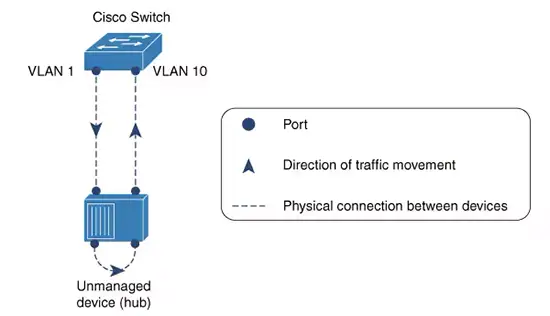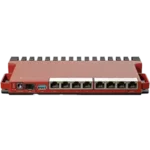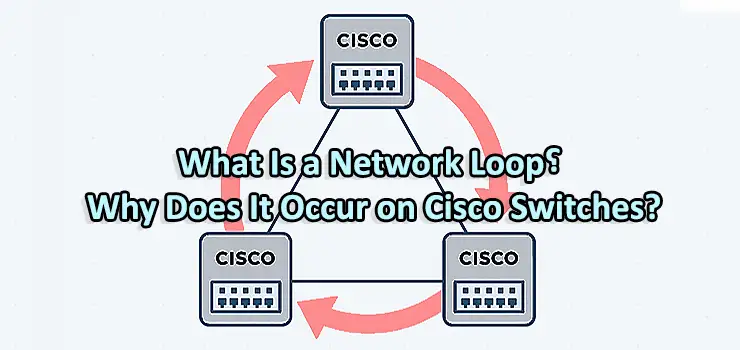A Network Loop is one of the most disruptive and dangerous issues that can occur inside a Layer 2 network. When even a single loop forms between switches, broadcast and multicast frames start circulating endlessly. This quickly leads to broadcast storms, high CPU usage, dropped connections, and eventually a complete network outage. Many companies experience this issue without understanding why it happens or how to prevent it, especially when Cisco switches are involved.
This article explains, in a clear and practical way, what a Network Loop is, why it occurs on Cisco switches, how to detect it, and best practices to avoid it. Whether you manage a small office network or a multi-building enterprise infrastructure, understanding Network Loop behavior is essential for maintaining a stable environment.
Understanding the Concept of a Network Loop
A Network Loop happens when there are multiple active Layer 2 paths between switches with no mechanism to block redundant links. Layer 2 switches forward frames based on MAC address tables, but they do not include any Time To Live value like IP packets do. This means a frame can circulate forever if a loop exists.
When a frame enters this loop, it travels from one switch to another and continues rotating. Because the frame never expires, it generates thousands of duplicates within seconds. These duplicated frames multiply into a broadcast storm that saturates the network.
In a normal network, STP (Spanning Tree Protocol) prevents this behavior by blocking redundant ports. But if STP is disabled, misconfigured, or overridden by topology changes, a Network Loop can form instantly.
Why a Network Loop Is So Dangerous
Many network administrators underestimate how quickly a Network Loop can bring an entire environment down. Some of the most critical effects include:
- Network bandwidth becomes saturated by repeating broadcast frames.
- Switch CPU usage reaches 100 percent, making management access impossible.
- End-user devices start losing connectivity or cannot obtain DHCP addresses.
- VoIP phones and IP cameras disconnect immediately due to packet flooding.
- Monitoring systems fail because SNMP and ping responses time out.
Within just a few seconds, even a large enterprise network can become completely unusable.
Why Network Loop Occurs on Cisco Switches
Cisco switches include advanced Layer 2 protection mechanisms, but Network Loop issues still happen when these protections are not configured properly. The most common reasons include:
Disabled or misconfigured STP
If Spanning Tree Protocol is disabled on a switch or on specific VLANs, Cisco cannot determine which ports should remain active and which should be blocked. As a result, redundant physical connections create an open loop.
Incorrect Root Bridge selection
When the wrong switch becomes the Root Bridge, STP may calculate inefficient or unstable paths. This can lead to unexpected forwarding states that allow a Network Loop to form during topology changes.
Connecting multiple switches without loop protection features
In many offices, a non-technical user accidentally connects two wall ports together with a patch cable, or connects two switch ports using an unmanaged extender. This instantly forms a loop, and if STP protection is missing, the loop becomes active.
Using unmanaged switches inside a Cisco environment
Unmanaged switches do not speak STP or BPDU. When placed between Cisco switches, they forward BPDUs blindly, which can make STP unaware of real topology changes.
EtherChannel misconfiguration
When bundling multiple ports in a Port-Channel, both sides must use the same mode (LACP or static). A mismatch results in one link being aggregated while the other is treated as a standalone uplink, creating a Layer 2 loop.
Accidental bridging through wireless or IoT devices
Some access points, printers, or IP camera NVRs have built-in switches. When connected incorrectly, they can bridge traffic across two paths and cause a loop that is difficult to trace.
Symptoms of a Network Loop on Cisco Switches
Even before the network becomes completely unreachable, Cisco switches show several signs of trouble:
- CPU utilization spikes to 90–100 percent.
- The MAC address table starts fluctuating rapidly.
- Interfaces show extremely high broadcast or multicast counts.
- SSH and web interfaces become slow or inaccessible.
- SNMP monitoring reports unusual traffic patterns.
- Users complain about slow internet, dropped VoIP calls, and intermittent connectivity.
When multiple switches show these symptoms at the same time, it is almost always a Network Loop.

How Cisco STP Prevents a Network Loop
Cisco uses several versions of STP to prevent looping:
- Classic STP (IEEE 802.1D)
- Rapid Spanning Tree (RSTP – 802.1w)
- Multiple Spanning Tree (MST – 802.1s)
- Cisco PVST and Rapid-PVST+
The basic idea behind all these protocols is the same:
Only one active forwarding path is allowed between any two parts of the network. All redundant paths are kept in a blocking state.
How STP works in simple terms
- A Root Bridge (the central switch) is chosen.
- Each switch calculates the best path to reach the Root.
- Ports that create loops are automatically transitioned into blocking mode.
- When a failure occurs, STP recalculates and activates a backup path.
This ensures redundancy without loops.
Common Scenarios Where STP Fails
Even with STP in place, certain events can disrupt topology and trigger a Network Loop:
STP disabled on access ports
Some administrators disable STP on access VLANs for “performance reasons,” not realizing that a single accidental cable connection can bring down the network.
BPDU Guard or PortFast not enabled
When a user connects another switch into a PortFast interface (such as a meeting room), the port may start forwarding too quickly, allowing a temporary loop.
Wrong VLAN configuration
If STP is active on some VLANs but disabled on others, a loop may occur only on specific VLANs, making troubleshooting more difficult.
Loops caused by unmanaged devices
Since unmanaged switches do not send BPDUs, Cisco cannot detect that a loop exists behind them.
How to Detect a Network Loop on Cisco Switches
Cisco provides several CLI commands that make loop detection faster:
- show spanning-tree detail: Shows topology changes and port states. If STP events increase rapidly, a loop likely exists.
- show processes cpu: If CPU is high and spanning-tree or ARP processes are consuming resources, looping traffic is present.
- show mac address-table dynamic: Flapping MAC entries indicate a loop.
- show interface counters errors: Broadcast counts increasing rapidly confirm looped traffic.

How to Fix a Network Loop
When a loop is active, the priority is to stabilize the network as quickly as possible.
Immediate actions
- Identify the switch with the highest broadcast traffic.
- Shut down suspected ports one by one.
- Disconnect unmanaged switches or rogue APs.
- Check for patch cables connecting two wall ports together.
Most loops are caused by simple physical mistakes.
Long-term solutions
To avoid future loops, apply the following Cisco best practices:
- Enable Rapid-PVST+ or MST across all switches.
- Configure BPDU Guard on access ports.
- Enable Loop Guard on trunk and uplink ports.
- Use Root Guard to prevent unauthorized Root Bridge changes.
- Configure EtherChannel correctly with LACP on both ends.
- Avoid using unmanaged switches or consumer devices in critical paths.
- Document all uplinks, patch panels, and VLANs clearly.
- Train users to avoid connecting two network ports together.
Practical Example of a Network Loop
A common example happens in office meeting rooms. A user sees two wall sockets and connects them with a short patch cable, thinking it will “improve speed.” Those ports are connected to two different switches in the wiring closet. The moment the cable is connected, both switches start receiving the same broadcast frames from two paths.
If STP is disabled or misconfigured, the frame begins circulating. Within seconds:
- Broadcast storms start.
- CPU rises.
- VoIP phones disconnect.
- CCTV cameras freeze.
- Administrators lose access to switches.
This scenario happens far more often than most people expect.
Importance of Network Loop Prevention in Modern Enterprises
Modern networks rely heavily on real-time traffic such as voice, video, cloud applications, and CCTV. Even a short loop can interrupt operations, cause financial loss, and damage equipment due to overheating.
Since Cisco switches operate as the backbone of many corporate networks, proper configuration and ongoing monitoring are essential to avoid downtime.
Cisco Switch Repair and Configuration Services in Dubai
If your Cisco switch is experiencing Network Loop problems, unexpected reloads, high CPU usage, or configuration issues, our team in Dubai provides professional repair, troubleshooting, and full configuration services. Whether you need STP optimization, uplink redesign, or complete switch installation, we can assist on-site anywhere in Dubai with fast response time and expert Cisco support.
Summary: Why Network Loop Must Be Taken Seriously
A Network Loop is not a minor configuration mistake. It is a critical failure that can shut down an entire business network. The main causes include incorrect STP settings, unmanaged switches, accidental cabling, and misconfigured EtherChannels. Cisco provides robust mechanisms to prevent loops, but they only work when configured correctly.
Companies that rely on Cisco infrastructure should regularly audit their STP configuration, train users, and follow Cisco’s recommended security features to guarantee a stable and reliable network.




















